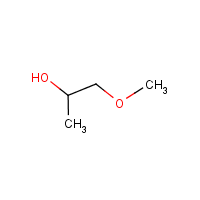Propylene glycol monomethyl ether
Agent Name
Propylene glycol monomethyl ether
Alternative Name
PGME
CAS Number
107-98-2
Formula
C4-H10-O2
Major Category
Solvents

Synonyms
1-Methoxy-2-hydroxypropane; 1-Methoxy-2-propanol; 2-Methoxy-1-methylethanol; 2-Propanol, 1-methoxy-; Closol; Dowanol 33B; Dowtherm 209; Methyl proxitol; PGME; Poly-Solve MPM; Propasol solvent M; Ucar Solvent LM (Obs.); [ChemIDplus] UN3092
Category
Glycol Ethers (P Series)
Description
Clear, colorless liquid with a mild, ethereal odor; [NIOSH]
Sources/Uses
Used as a solvent in paints, inks, nail polish removers, and cleaning agents; Also used in finishing leather and in electronics and agriculture; [ACGIH] Used to make lacquers and paints, as a solvent for resins, celluloses, acrylics, dyes, and inks (gravure, flexographic and silk screening), as antifreeze, and in household cleaners and spot removers; [HSDB]
Comments
Rats inhaling 3000 ppm, 6 hours/day for 9 days, show signs of sedation, but tissue examination shows no evidence of gross or microscopic disease. Similarly exposed rats had increased liver weights after 6 months; Human volunteers exposed to 2500 ppm had severe lacrimation and painful breathing; In another human experiment, subjects complained of slight eye effects at 150 ppm, but not at 100 ppm; "TLV Basis" is eye and upper respiratory tract irritation; [ACGIH] A lachrymator; [CHEMINFO] A skin, eye, and respiratory tract irritant; Inhalation of high concentrations can cause CNS depression; [ICSC] See "Glycol ethers."
Biomedical References
Exposure Assessment
Skin Designation (ACGIH)
Insufficient data
TLV (ACGIH)
50 ppm
STEL (ACGIH)
100 ppm
MAK
100 ppm
Vapor Pressure
12.5 mm Hg
Odor Threshold Low
10 ppm
Odor Threshold High
100 ppm
Lethal Concentration
LC50 (rat) = 10,000 ppm/5h
Explanatory Notes
Odor threshold from CHEMINFO, low (detection), high (objectionable); Flash point = 32 deg C; VP from HSDB;
Reference Link #2
NFPA
may ignite at ambient temp
Adverse Effects
Lachrymator
Yes
Neurotoxin
Acute solvent syndrome
ACGIH Carcinogen
Not Classifiable
Diseases, Processes, and Activities Linked to This Agent
Diseases
Occupational diseases associated with exposure to this agent:
Processes
Industrial Processes with risk of exposure: